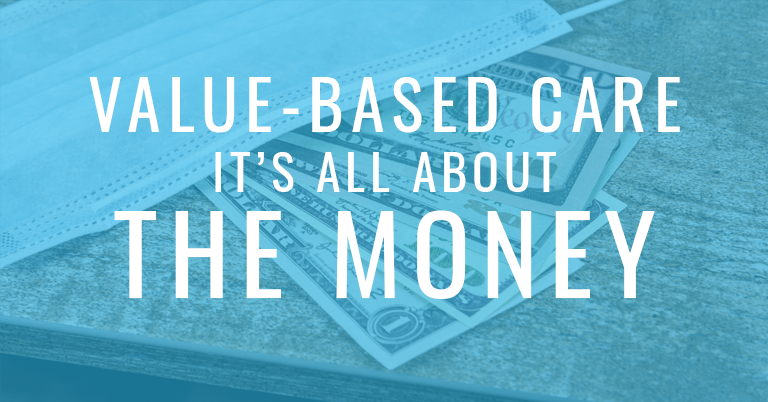A guest walks into an upscale hotel and unburdens himself of several suitcases into the waiting hands of an eager bellhop. When both arrive at the room, rather than giving a tip, the guest offers a hearty thanks! With a dry smile, the bellhop frankly states, “‘Thank you’ don’t feed the bulldog.”
And he’s right. For all the talk of improving outcomes and reducing costs, it takes money to provide the kind of care that truly improves outcomes. But in the same breath, caring for the health of a population is very clearly not about the money. So how does a $4+ TRILLION-with-a-T industry improve outcomes and reduce costs while balancing on the razor-thin line that both is and is not about the money?
In the Value-Based Care space, the full risk model is often called the “silver bullet,” AKA the only thing going that is trending toward a sustainable solution. Full risk is, in fact, all about the money: how it is deployed, where it is directed, and what mechanisms are in place to either gain or lose the money.
(But also, it’s not about the money.)
Provider groups are not jumping ship from their traditional fee-for-service model into full risk because each clinician in the group finds herself in need of a new boat. The transition from FFS to VBC is driven by that same spark that drew optimistic kids out of college and into medical school: the desire to help people.
And nothing helps people stay healthy like a full risk model, or as it’s known in some corners of the world, “Mutual Assured Destruction.”
The HCPLAN’s annual report (Health Care Payment Learning & Action Network) shows a slow but consistent rise in dollars spent in VBC arrangements, and a glacially slow (but steady!) decline in dollars spent in FFS arrangements.

The proof is in the pudding. And the pudding is made out of data. Humana’s Chief Medical Officer, William Shrank, MD, MSHS, co-wrote a study in March that seeks to answer the correlation between avoidable hospital visits and models of payment and risk. Analysis of Value-Based Payment and Acute Care Use Among Medicare Advantage Beneficiaries (Gondi S, Li Y, Drzayich Antol D, Boudreau E, Shrank WH, Powers BW. Analysis of Value-Based Payment and Acute Care Use Among Medicare Advantage Beneficiaries. JAMA Netw Open. 2022;5(3):e222916. doi:10.1001/jamanetworkopen.2022.2916).
In that piece, we see the smoking gun that fired the silver bullet that is gradually improving outcomes and reducing costs:
| Compared with FFS, beneficiaries cared for under 2-sided risk models had lower rates of hospitalizations, observation stays, and ED visits. For example, the adjusted rate of ED visits per 1000 patients for 2-sided risk models was 375.8 (95% CI, 370.9-380.7) compared with 434.1 (95% CI, 426.5-441.9) for FFS. For all outcomes, there was no significant difference in acute care use between beneficiaries cared for under upside-only risk models and FFS.
The association between value-based payment and decreased acute care use was most pronounced for measures of avoidable acute care use. Compared with FFS, 2-sided risk models were associated with a 15.6% (95% CI, 14.2%-17.0%) relative reduction in avoidable hospitalizations, compared with 4.2% (3.4%-4.9%) for all-cause hospitalizations |

So in a fair fight, when it comes to reducing avoidable hospitalizations, full risk—or 2-sided risk, downside risk—beats both FFS AND shared savings by a healthy margin.
You have probably heard the phrase “the fear of pain is a greater motivator than the desire for pleasure.” Freud, Maslow, and even Psychology Today speak to this, but very few examples illustrate the principle so vividly as when comparing upside risk or “shared savings” (a reward) against 2-sided risk models (full risk, AKA the opportunity to lose money).
This is also known as “aligning incentives.” Simply put, if Jerry stays healthy, Jerry’s doctor keeps more money, but if Jerry takes a costly trip to the ED (Expensive Department), his full-risk-bearing healthcare provider pays the piper.
While Jerry may be motivated to keep his diabetes under control and stick with his medication, his provider is financially incentivized to do all of the things that reduce those avoidable hospitalizations.
Beyond the annual wellness visit, there are myriad things that are shown to reduce those acute events. Send Jerry home with a remote patient monitoring device and assign staff to monitor the results. Call Jerry to ensure he’s doing okay. Ensure he has transportation to and from the clinic. Offer other services in clinic to make Jerry want to come for a visit. (Looking at you, Florida, with the haircuts, mani-pedis, fresh produce, mental health counseling, and full-time massage therapist, all at no cost to Jerry.)
Obviously, in the relationship between money and healthcare, it’s complicated…. But by shifting risk in the direction of providers, the data show that avoidable hospitalizations are less and outcomes are improving, which directly impacts cost of care.
Healthier patients, happier doctors, silver bullet.
Want your team to master HCC coding faster with better long-term retention, boosting RAF accuracy and earning 25 hours of accredited CME?

